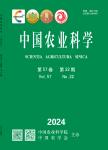Genetic Diversity and Evolutionary Tendency Detected by Isozyme, RFLP and RAPD Markers in the Wild and Cultivated Soybean in China
Genetic Diversity and Evolutionary Tendency Detected by Isozyme, RFLP and RAPD Markers in the Wild and Cultivated Soybean in China作者机构:Soybean Research Institute Nanjing Agricultural University National Center of Soybean Improvement Ministry of Agriculture Nanjing 210095 China Genetic Institute China Academy of Sciences Faculty of Agriculture Hokkaido University Sapporo 060 Japan
出 版 物:《Agricultural Sciences in China》 (中国农业科学(英文版))
年 卷 期:2000年第1期
页 面:48-55页
核心收录:
学科分类:09[农学]
主 题:Wild soybean (Glycine soja Sieb. et Zucc. ) Cultivated soybean 〔Glycine max (L.)Merr.〕 Genetic diversity Genetic evolution
摘 要:A large numbers of samples of wild soybean accessions and cultivated soybean landraces from various areas in China were analyzed by isozyrme, cytoplasmic DNA RFLP and nuclear DNA RAPD markers in order to reveal their genetic diversity. Greater comprehensive genetic diversity was detected in wild soybean than in cultivated soybean. The genetic plentifulness and the genetic dispersion of wild soybean were 180 (95. 2%) and 0. 2891 while those of cultivated soybean were 154(81.5%) and 0. 2091,respectively. On the most loci, especially on isozyme loci Idh1, Aph, Idh2,and Dia, cytoplasmic DNA RFLP loci cp Ⅰ , cp Ⅲ, mt Ⅳ a and mt Ⅳ b, and nuclear RAPD loci OPAP4-8, OPAP5-1, OPAP9-8 and OPAP20-8, the wild soybeans djffered remarkably from the cultivated ones in allele frequency. These markers could be used in further study on the evolution and origin of the cultivated soybean.



